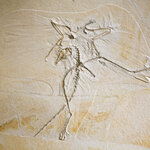Archaeology

During the television program Ulysses which aired in Italy on Saturday the 28th of February, the well-known scientific divulgator Piero Angela stated that a secret drawing, a youthful self-portrait of Leonardo da Vinci, had just been discovered. Actually, the Leonardo3 ( http://www.leonardo3.net) research center in Milan, Italy, had published its own edition of the Codex of Flight (book interactive software) in the October of 2007: this work included the digital restoration of page 10, revealing the underlying portrait. The same center had also created a 3D reconstruction of the image.
At…

A biochemical analysis of a rare Clovis-era stone tool cache recently unearthed in the city limits of Boulder, Colo., indicates some of the implements were used to butcher ice-age camels and horses that roamed North America until their extinction about 13,000 years ago, according to a University of Colorado at Boulder study.
The study is the first to identify protein residue from extinct camels on North American stone tools and only the second to identify horse protein residue on a Clovis-age tool, said CU-Boulder Anthropology Professor Douglas Bamforth, who led the study. The cache is one of…

Roman artefacts which are nearly two thousand years old with similarities to ancient remains found at Pompeii in Italy will be examined at the Science and Technology Facilities Council’s ISIS neutron source in Oxfordshire this weekend. Researchers hope to learn more about English heritage by discovering whether the items were imported from southern Italy, or manufactured using similar techniques in Britain.
The bronze artifacts, which include a wine-mixing vessel, jugs and ceremonial pan-shaped objects, were discovered in Kent in two high status Roman pit-burials that are among…

The Archaeopteryx is experiencing a phoenix-like reascent to fossil celebrity status. The disovery of this clearly birdlike dinosaur in 1861 lent ethos to Darwin’s brand new Theory of Evolution. In December, the Thermopolis, WY archaeopteryx fossil was escorted to the Stanford Synchrotron Radiation Lightsource laboratory for synchrotron X-ray analysis. According to researcher Uwe Bergmann, "What you normally can't see are the chemical elements from the original organism that might still be present in the fossil. Using X-ray fluorescence imaging, we can bring these elements…

It's not quite a "Book of the Dead" but a 14th century brick oven uncovered by archaeologists in Spain found a unique use for animal bones just the same - strengthening city fortifications. The scientists report that the animal bones were burnt in the oven and mixed with other materials to produce a protective coating that strengthened the grand medieval walls of what is today Granada, Spain. It must have worked pretty well since Granada and the surrounding territory were the last bastion of Islamic Iberia during that period.
In a study scheduled to appear in the Jan. 15…

HUMANS have actively changed the coats of domestic animals by cherry-picking rare genetic mutations, causing variations such as different colours, bands and spots, according to a new study.
Although the study was carried out on pigs, the results can explain the evolution in the coat colors of all domesticated animals as they all express the same melanocortin-1 receptor (MC1R) gene, one of the genes that controls coat colour in animals.
The study also explains for the first time why there is a stark contrast between the coat colors of wild and domestic animals and gives further…

A researcher from the University of Leicester has identified what looks to be the oldest archaeological evidence for chemical warfare--from Roman times. At the meeting of the Archaeological Institute of America, Simon James presented CSI-style arguments that about twenty Roman soldiers, found in a siege-mine at the city of Dura-Europos, Syria, met their deaths not as a result of sword or spear, but through asphyxiation.
Dura-Europos on the Euphrates was conquered by the Romans who installed a large garrison. Around AD 256, the city was subjected to a ferocious siege by an army from the…

A 2000-year-old painted statue is being restored to her original glory by scientists from Warwick Manufacturing Group (WMG), an academic department of the University of Warwick, along with the University of Southampton and the Herculaneum Conservation Project.
The Roman statue was discovered by the Herculaneum Conservation Project in the ancient ruins of Herculaneum, a town preserved in the same eruption that buried nearby Pompeii in AD 79. It is thought to represent a wounded Amazon warrior, complete with painted hair and eyes preserved by the ash that buried the town. Archaeologists…

The mystery of why ancient South American peoples who created the mysterious Nazca Lines also collected human heads as trophies has long puzzled scholars who theorize the heads may have been used in fertility rites, taken from enemies in battle or associated with ancestor veneration.
A recent study using specimens from Chicago's Field Museum throws new light on the matter by establishing that trophy heads came from people who lived in the same place and were part of the same culture as those who collected them. These people lived 2,000 to 1,500 years ago.
Archaeologists determined that…

A research team led by Professor Michael Chazan, director of the University of Toronto's Archaeology Centre, has discovered the earliest evidence of our cave-dwelling human ancestors at the Wonderwerk Cave in South Africa.
Stone tools found at the bottom level of the cave — believed to be 2 million years old — show that human ancestors were in the cave earlier than ever thought before. Geological evidence indicates that these tools were left in the cave and not washed into the site from the outside world.
Archaeological investigations of the Wonderwerk cave — a South African National Heritage…